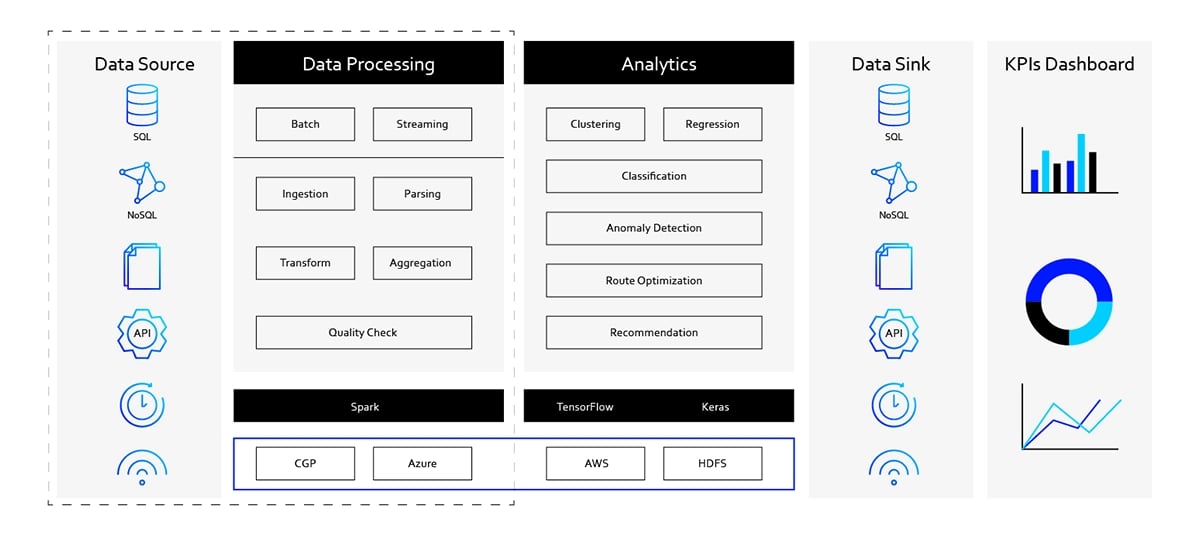
Modern leaders understand the importance of data in their organizations. They know access to the right data can help them take the competitive lead in their industry.
They know they can use data to make decisions that will:
If you’re going to lead your industry and maintain a competitive advantage, you need to know how to make the most of the data you have. Data science, machine learning, and artificial intelligence (AI) are invaluable in your success — if your organizational leaders are ready to adopt them and utilize them effectively.
Are you ready to make the leap into the future of organizational optimization?
We’ve been helping transform industry-leading companies like yours for decades, and we know what it takes to adopt AI successfully.
You have the technology, and you have a plan for implementation — but, are you really ready to put AI into place in your company? These steps will show you how.
Organizations that are AI-ready have a culture of expectation that decisions are based on data. This culture is created at the very top level, from the C-suite down through all the levels of responsibility. It falls on executive leadership to establish that:
That data is treated as a core competency and strategic asset
That data is trusted and democratized: a company’s employees should have equal access to the data they need and want, easily and intuitively
Business decisions are anchored in data
Without leadership setting the example, the company as a whole will not be governed by data, and any AI initiatives completed will not necessarily be trusted and actioned, thereby rendering them useless. It is imperative that a company begin with using data as its North Star in driving analysis, decision-making, and actions. Many companies have chief data officers (CDOs) or chief intelligence officers (CIOs) whose primary responsibility is to create this culture of data integrity and leadership.
Once leadership has established a data-driven culture, you need a comprehensive data strategy.
Your data strategy should include how you’re going to organize, analyze, govern, and deploy your informational assets. If you fail to take all of this into account, you open your company up to data breaches and miss out on opportunities to make smarter decisions.
Generally, data strategies fall under two main categories - offensive and defensive.
Defense is primarily focused on minimizing downside costs and risks. Activities include using analytics to detect and reduce fraud, ensure compliance with industry regulations, and build systems that are designed to prevent theft. Example industries: Healthcare, Banking, Financial Services.
Offense focuses on strengthening and building on business objectives, such as increasing revenue, customer satisfaction, and profitability. You’ll implement systems and processes to generate customer insights and integrate disparate customer and market data. Example industries: Retail, Telecom, Entertainment.

AI can be useful in a myriad of ways across your company — but which use cases should you pilot?
Start by prioritizing the top 3-5 use cases for AI in your organization that will answer the most important questions and that have a robust enough data set to leverage.
Potential use case examples:
Before attempting to pilot an AI use case, you must ensure that you have high-quality data to use. With poor data quality, your results will be wrong, confusing, or inconclusive thereby, wasting your efforts to run a pilot test.
Therefore,
A holistic approach to achieving data quality starts with enabling information to be distributed across your company more efficiently and consistently. Here are the key phases of data flow:
|
Data Accuracy |
Data must be accurate, organized, de-duplicated, and adequately labeled. |
|
Adequate Data Volume |
Sufficient data volume and variety are also key. |
|
Short-time Horizon |
Organizations usually only have access to the data for a fixed amount of time — such as only having access to one month’s worth of data. |
|
Siloed Data |
Tons of legacy data in disparate systems that don't work well with each other. Siloed data leads to siloed intelligence. |
|
Fragmented Data |
You can’t unify the data to get real-time visualization and insights that can be harnessed and crunched by artificial intelligence. |
|
Unusable Data |
Data that cannot be analyzed and used to drive business impact might as well not exist. |
|
Outlier Data |
A common tendency is to ignore outliers. However, outlier data must be incorporated into models to ensure the highest levels of accuracy for decision-making. |
Intelligent decisions are often made using data from multiple sources or refined from a wider range of information. If you had to narrow down your wealth of data into a more streamlined repository, how fast could you do it?
Would you be able to keep that information up-to-date as new data flowed in — or would you be limited to a static dataset frozen in time at the moment of construction?
Having the right frameworks and tools is key to helping you take your vast amount of disparate data and integrate it into a single, usable source. Nisum offers comprehensive Data Ingestion Accelerators that rapidly and securely ingest all your multiple sources of data into one master data lake - in real-time - for easy reporting, visualization, and insights extraction.


After a successful pilot, you need to decide how and where to scale the AI usage in other use cases across the organization.
In Wave 1, the focus is on a particular set of decisions to change. Pick a specific set of use cases within and across marketing, sales, supply chain, operations, etc. Then, in successive “waves,” additional and more complex data elements across a variety of sources (unstructured data, external data from partners, government, institutions) can be added. Then, you can build and continually refine the champion models for those use cases.
Some organizations focus on building a data-driven culture within a specific business unit as the initial testbed and then build successive waves for other business units.
For example, a bank may start with Banking and Corporate Services units, then move to Wealth Management, Asset Management, and Risk Management in future waves. As success is realized, more and more business units, or waves, stand to benefit. This allows value to be maximized across the entire organization.
Are you ready to take your company’s analytics capabilities to the next level with sophisticated artificial intelligence applications? If so, reach out to Nisum’s Insights and Analytics team to help you. We are a team of long-tenured experts in data science, data engineering, and data visualization, utilizing the most future-forward technology to turn your data into actionable insights that produce business value.
Learn What Insights & Analytics Can Do for You
Reach out to learn how we can help your
business.